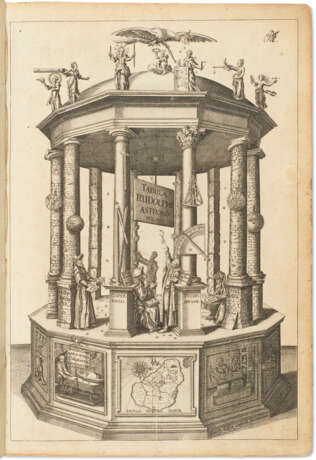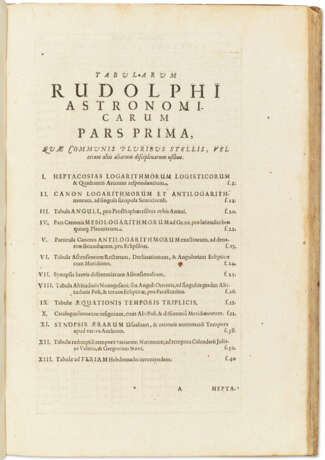ID 1360824
Lot 108 | Tabulae Rudolphinae
Valeur estimée
$ 15 000 – 25 000
First edition of Kepler’s last lifetime publication and crowning legacy, establishing the evidentiary foundation of his laws of planetary motion for all the planets of the solar system. Owned by four astronomers, from the 18th to the 21st century. “For Kepler [his tables were] the substantiation of his laws of planetary motion … The geocentric world view was broken and the heliocentric system, together with Kepler’s laws of planetary motion, triumphed” (Gingerich). The tables are based on Tycho Brahe’s observations, supplemented by Kepler’s own, with positions recalculated according to Kepler’s laws of planetary orbits. The calculations were a formidable mathematical achievement. Tycho’s data, collected over many years with the help of many assistants, pertained to “perfect” circular orbits, and Kepler had to recalculate everything according to the planets’ true elliptical orbits. “Another innovation completely altered Kepler’s original plan for the form of the tables—'a happy calamity,’ as he called it. In 1617 Kepler first saw John Napier’s epoch-making work on logarithms and was deeply impressed by it, recognizing how this new invention would simplify the time-consuming computations of astronomy” (ibid). The fine engraved allegorical title was designed by Kepler himself and executed by Georg Celer. It depicts the Temple of Urania inhabited by great astronomers of the past, with Copernicus and Tycho front and center. Kepler himself is in a downstairs room, working on the mystery of the cosmos.
Tycho had entrusted Kepler on his deathbed to complete his planetary tables and secure his legacy, but over the 26 years that it took Kepler to complete this task, the work became his own. Legal complications with Tycho's heirs plagued the project; for this reason, Kepler included a dedication by Tycho’s heirs to the Emperor as well as one of his own. The heirs took exception to Kepler's dedication being longer than theirs; the result is that this work is bibliographically complex, with a series of changes to the title and first two gatherings. There are three states of this printing; this copy has the second setting of the first signature and the third setting of the second signature. Some copies are known with an added world map and 4-leaf text entitled the Sportula (Caspar 79.1), not present here. Caspar 79; Houzeau and Lancaster 12754; Norman 1208; Sparrow 116. See Owen Gingerich, “Johannes Kepler and the Rudolphine Tables” in Sky and Telescope, 42 (1971), pp 328-33 (reprinted in The Great Copernicus Chase, 1992) for more on the frontispiece and Gingerich, “Johannes Kepler and the New Astronomy,” in the Quarterly Journal of the Royal Astronomical Society v 13 (1972).
Folio (342 x 234mm). Engraved allegorical additional title by Celer; numerous woodcut diagrams in text (first three leaves, including additional title, a bit worn on the fore-edge and a little strengthened, intermittent very pale marginal dampstain, tiny marginal burn-hole to a1, majority of gatherings browned as usual, but mostly at the beginning). Contemporary vellum over boards, spine lettered in manuscript (soiled and slightly bowed/worn, endleaves browned); linen clamshell box. Provenance: D.H. Fischer (ownership inscription on title and monogram initials on additional title) – [Johann Gottlieb Friedrich von] Bohnenberger, German astronomer (1765-1831; gift inscription dated November 1788 to verso of additional title and ownership inscription on front free endpaper) – Dr. [Ludwig Felix] Ofterdinger, mathematician and Kepler historian (1810-1896, ownership inscription dated December 1831 to f.f.e.) – Samuel Verplanck Hoffman, professor of astronomy and later President of the New-York Historical Society (1866-1942, bookplate) – Owen Gingerich (bookplate).
| Adresse de l'enchère |
CHRISTIE'S 20 Rockefeller Plaza 10020 New York Etats-Unis | ||||||||||||||
|---|---|---|---|---|---|---|---|---|---|---|---|---|---|---|---|
| Aperçu |
| ||||||||||||||
| Téléphone | +1 212 636 2000 | ||||||||||||||
| Fax | +1 212 636 4930 | ||||||||||||||
| Conditions d'utilisation | Conditions d'utilisation | ||||||||||||||
| transport |
Service postal Service de messagerie ramassage par vous-même | ||||||||||||||
| Modes de paiement |
Virement bancaire | ||||||||||||||
| Heures d'ouverture | Heures d'ouverture
|




